Numerical Investigation of the Effect of Sudden Expansion Ratio of Solid Fuel Ramjet Combustor with Swirling Turbulent Reacting Flow
Abstract
:1. Introduction
2. Experimental Setup and Procedures
3. Mathematical Method
3.1. RANS Equations
3.2. Governing Equations of Solid Domain
3.3. Numerical Method
3.4. Chemical Reaction Model
3.5. Boundary Conditions
4. Case Description
5. Computational Models and Model Validation
5.1. Computational Models
5.2. Model Validation
6. Results and Discussion
6.1. Flow Field Characteristics
6.2. Theoretical Analysis of SFRJ Performance
6.3. Effects of Sudden Expansion Ratio on Regression Rate
7. Conclusions
- The physical reasons for the regression rate that are affected by the sudden expansion ratio were obtained. The variation of turbulent viscosity due to the sudden expansion ratio changes could significantly affect the solid fuel regression rate and the fuel surface heat transfer.
- It becomes evident that the combustion process is closely related to the heat transfer process of solid fuel surface. Based on the analysis of the heat transfer coefficient, the self-sustained combustion occurs around the reattachment point at first, and then gradually spread to the redevelopment zone. The heat released in the reattachment point will be used to achieve the self-sustained combustion in the redevelopment zone.
- The linear relationship between the sudden expansion ratio with fixed port diameter and average/maximum regression rate was obtained. The result indicates that the average regression rate and maximum regression rate are more sensitive to the change of the port-to-inlet diameter. Additionally, the overall heat transfer behavior of the fuel surface was mostly dominated by the maximum heat transfer around the backward-facing step.
- Based on the analysis of linear relationship between regression rate and sudden expansion ratio with fixed inlet diameter. The average regression rate is mainly affected by heat transfer mechanism in a fully developed turbulent flow in rthe edevelopment zone, and it decreased with the increasing of the sudden expansion ratio.
Author Contributions
Funding
Conflicts of Interest
Nomenclature
| Q | conservative vectors | |
| E | convective flux vectors | |
| F | convective flux vectors | |
| EV | viscous flux vectors | |
| FV | viscous flux vectors | |
| H | axisymmetric source terms of convective flux vectors | |
| HV | axisymmetric source terms of viscous flux vectors | |
| S | source term produced by chemical reaction | |
| T | temperature | K |
| Subscripts | ||
| x | x direction | |
| y | y direction | |
| θ | θ direction | |
| Abbreviation | ||
| SFRJ | Solid fuel ramjet | |
| HDPE | high-density Polyethylene |
References
- Schulte, G. Fuel regression and flame stabilization studies of solid-fuel ramjets. J. Propuls. Power 1986, 2, 301–304. [Google Scholar] [CrossRef]
- Gany, A.; Levy, Y.; Zvuloni, R. Geometric effects on the combustion in solid fuel ramjets. J. Propuls. Power 1989, 5, 32–37. [Google Scholar] [CrossRef]
- Ferreira, J.; Carvalho, J., Jr.; Silva, M. Experimental investigation of polyethylene combustion in a solid fuel ramjet. In Proceedings of the 32nd Joint Propulsion Conference and Exhibit, Washington, DC, USA, 1–3 July 1996. [Google Scholar]
- Gong, L.K.; Chen, X.; Zhou, C.S.; Li, Y. Numerical investigation on effect of solid fuel ramjet geometry on solid fuel regression rate. Acta Armament. 2016, 37, 798–807. (In Chinese) [Google Scholar]
- Key, N.; Miller, K.L.; Fulayter, R.D. Lessons Learned from an Aggressive Outlet Vane Design for Axial Compressors. J. Propuls. Power 2012, 28, 918–926. [Google Scholar] [CrossRef]
- Hsu, K.Y.; Carter, C.D.; Gruber, M.R.; Barhorst, T.; Smith, S. Experimental study of cavity-strut combustion in supersonic flow. J. Propuls. Power 2010, 26, 1237–1246. [Google Scholar] [CrossRef]
- Ghodke, C.; Retaureau, G.; Choi, J.; Menon, S. Numerical and experimental studies of flame stability in a cavity stabilized hydrocarbon-fueled scramjet. In Proceedings of the AIAA International Space Planes & Hypersonic Systems & Technologies Conference, San Francisco, CA, USA, 11–14 April 2011. [Google Scholar]
- Ghodke, C.; Choi, J.; Srinivasan, S.; Menon, S. Large eddy simulation of supersonic combustion in a cavity-strut flameholder. In Proceedings of the 49th AIAA Aerospace Sciences Meeting including the New Horizons Forum and Aerospace Exposition, Orlando, FL, USA, 4–7 January 2011. [Google Scholar]
- Hoegl, A.; Duesterhaus, D. Measurement in a solid fuel ramjet combustion with swirl. In Proceedings of the 24th Joint Propulsion Conference, Boston, MA, USA, 11–13 July 1988. [Google Scholar]
- Li, Y.; Li, R.; Li, D.; Bao, J.; Zhang, P. Combustion characteristics of a slotted swirl combustor: An experimental test and numerical validation. Int. Commun. Heat Mass Transf. 2015, 66, 140–147. [Google Scholar] [CrossRef]
- Tahsini, A.M. Ignition delay time in swirling supersonic flow. Acta Astronaut. 2013, 83, 91–96. [Google Scholar] [CrossRef]
- Jing, J.; Li, Z.; Zhu, Q.; Chen, Z.; Wang, L.; Chen, L. Influence of the outer secondary air vane angle on the gas/particle flow characteristics near the double swirl flow burner region. Energy 2011, 36, 258–267. [Google Scholar] [CrossRef]
- Gassoumi, T.; Guedri, K.; Said, R. Numerical study of the swirl effect on a coaxial jet combustor flame including radiative heat transfer. Numer. Heat Transf. Part A Appl. 2009, 56, 897–913. [Google Scholar] [CrossRef]
- Nemoda, S.; Bakić, V.; Oka, S.; Zivković, G.; Crnomarković, N. Experimental and numerical investigation of gaseous fuel combustion in swirl chamber. Int. Commun. Heat Mass Transf. 2005, 48, 4623–4632. [Google Scholar] [CrossRef]
- Orbay, R.C.; Nogenmyr, K.J.; Klingmann, J.; Bai, X.S. Swirling turbulent flows in a combustion chamber with and without heat release. Fuel 2013, 104, 133–146. [Google Scholar] [CrossRef]
- Campbell, W.H., Jr. An Experimental Investigation of the Effects of Swirling Air Flows on the Combustion Properties of a Solid Fuel Ramjet Motor; Naval Postgraduate School Monterey: Monterey, CA, USA, 1985. [Google Scholar]
- Musa, O.; Xiong, C.; Changsheng, Z.; Li, W. Effect of inlet conditions on swirling turbulent reacting flows in a solid fuel ramjet engine. Appl. Therm. Eng. 2017, 113, 186–207. [Google Scholar] [CrossRef]
- Musa, O.; Xiong, C.; Changsheng, Z. Experimental and numerical investigation on the ignition and combustion stability in solid fuel ramjet with swirling flow. Acta Astronaut. 2017, 137, 157–167. [Google Scholar] [CrossRef]
- Musa, O.; Xiong, C.; Changsheng, Z.; Lunkun, G. Assessment of the modified rotation/curvature correction SST turbulence model for simulating swirling reacting unsteady flows in a solid-fuel ramjet engine. Acta Astronaut. 2016, 129, 241–252. [Google Scholar] [CrossRef]
- Musa, O.; Xiong, C.; Chang-Sheng, Z.; Ying-Kun, L.; Wen-He, L. Investigations on the influence of swirl intensity on solid-fuel ramjet engine. Comput. Fluids 2018, 167, 82–99. [Google Scholar] [CrossRef]
- Krishnan, S.; George, P. Solid fuel ramjet combustor design. Prog. Aerosp. Sci. 1998, 34, 219–256. [Google Scholar] [CrossRef]
- Li, W.; Chen, X.; Musa, O.; Gong, L.; Zhu, L. Investigation of the effect of geometry of combustor on combustion characteristics of solid-fuel ramjet with swirl flow. Appl. Therm. Eng. 2018, 145, 229–244. [Google Scholar] [CrossRef]
- Kuo, K.K. Principles of Combustion; John Wiley: Hoboken, NJ, USA, 2005. [Google Scholar]
- Chen, J. Combustion Fundamental of Solid Rocket; Nanjing University of Science and Technology Press: Nanjing, China, 2011. (In Chinese) [Google Scholar]
- Kee, R.J.; Rupley, F.M.; Meeks, E.; Miller, J.A. CHEMKIN-III: A FORTRAN Chemical Kinetics Package for the Analysis of Gas-Phase Chemical and Plasma Kinetics; Sandia National Labs.: Livermore, CA, USA, 1996.
- Stoliarov, S.I.; Walters, R.N. Determination of the heats of gasification of polymers using differential scanning calorimetry. Polym. Degrad. Stab. 2008, 93, 422–427. [Google Scholar] [CrossRef]
- Bianchi, D.; Nasuti, F.; Onofri, M. Radius of curvature effects on throat thermochemical erosion in solid rocket motors. J. Spacecr. Rockets 2014, 52, 320–330. [Google Scholar] [CrossRef]
- Menter, F.R. Two-equation eddy-viscosity turbulence models for engineering applications. AIAA J. 1994, 32, 1598–1605. [Google Scholar] [CrossRef]
- Vieser, W. Heat Transfer Predictions Using Advanced Two-Equation Turbulence Models; CFX Technical Memorandum (CFX-VAL10/0602); CFX: Lahore, Pakistan, 2002. [Google Scholar]
- Kim, K.H.; Kim, C.; Rho, O.H. Methods for the accurate computations of hypersonic flows: I. AUSMPW+ scheme. J. Comput. Phys. 2001, 174, 38–80. [Google Scholar] [CrossRef]
- Zhang, L.P.; Wang, Z.J. A block LU-SGS implicit dual time-stepping algorithm for hybrid dynamic meshes. Comput. Fluids 2004, 33, 891–916. [Google Scholar] [CrossRef]
- Blazek, J. Computational Fluid Dynamics: Principles and Applications; Butterworth-Heinemann: Oxford, UK, 2015. [Google Scholar]
- Musa, O.; Xiong, C.; Changsheng, Z.; Min, Z. Combustion modeling of unsteady reacting swirling flow in solid fuel ramjet. In Proceedings of the International Conference on Mechanical, Montreal, QC, Canada, 28–29 March 2017. [Google Scholar]
- Schulte, G.; Pein, R.; Högl, A. Temperature and concentration measurements in a solid fuel ramjet combustion chamber. J. Propuls. Power 1987, 3, 114–120. [Google Scholar] [CrossRef]
- Baurle, R.; Mathur, T.; Gruber, M.; Jackson, K. A numerical and experimental investigation of a scramjet combustor for hypersonic missile applications. In Proceedings of the 34th AIAA/ASME/SAE/ASEE Joint Propulsion Conference and Exhibit, Cleveland, OH, USA, 13–15 July 1998. [Google Scholar]
- Chiaverini, M.J.; Harting, G.C.; Lu, Y.C.; Kuo, K.K.; Peretz, A.; Jones, H.S.; Wygle, B.S.; Arves, J.P. Pyrolysis behavior of hybrid-rocket solid fuels under rapid heating conditions. J. Propuls. Power 1999, 15, 888–895. [Google Scholar] [CrossRef]
- Gong, L.; Chen, X.; Musa, O.; Yang, H.; Zhou, C. Numerical and experimental investigation of the effect of geometry on combustion characteristics of solid-fuel ramjet. Acta Astronaut. 2017, 141, 110–122. [Google Scholar] [CrossRef]
- Dellenback, P.A.; Metzger, D.E.; Neitzel, G.P. Measurements in turbulent swirling flow through an abrupt axisymmetric expansion. AIAA J. 1988, 26, 669–681. [Google Scholar] [CrossRef]
- Nejad, A.S.; Vanka, S.P.; Favaloro, S.C.; Samimy, M.; Langenfeld, C. Application of laser velocimetry for characterization of confined swirling flow. J. Eng. Gas Turbines Power 1989, 111, 36–45. [Google Scholar] [CrossRef]
- Lehr, H.F. Experiments on shock-induced combustion. Astronaut. Acta 1972, 17, 589–597. [Google Scholar]
- Jaojaruek, K. Mathematical model to predict temperature profile and air–fuel equivalence ratio of a downdraft gasification process. Energy Convers. Manag. 2014, 83, 223–231. [Google Scholar] [CrossRef]



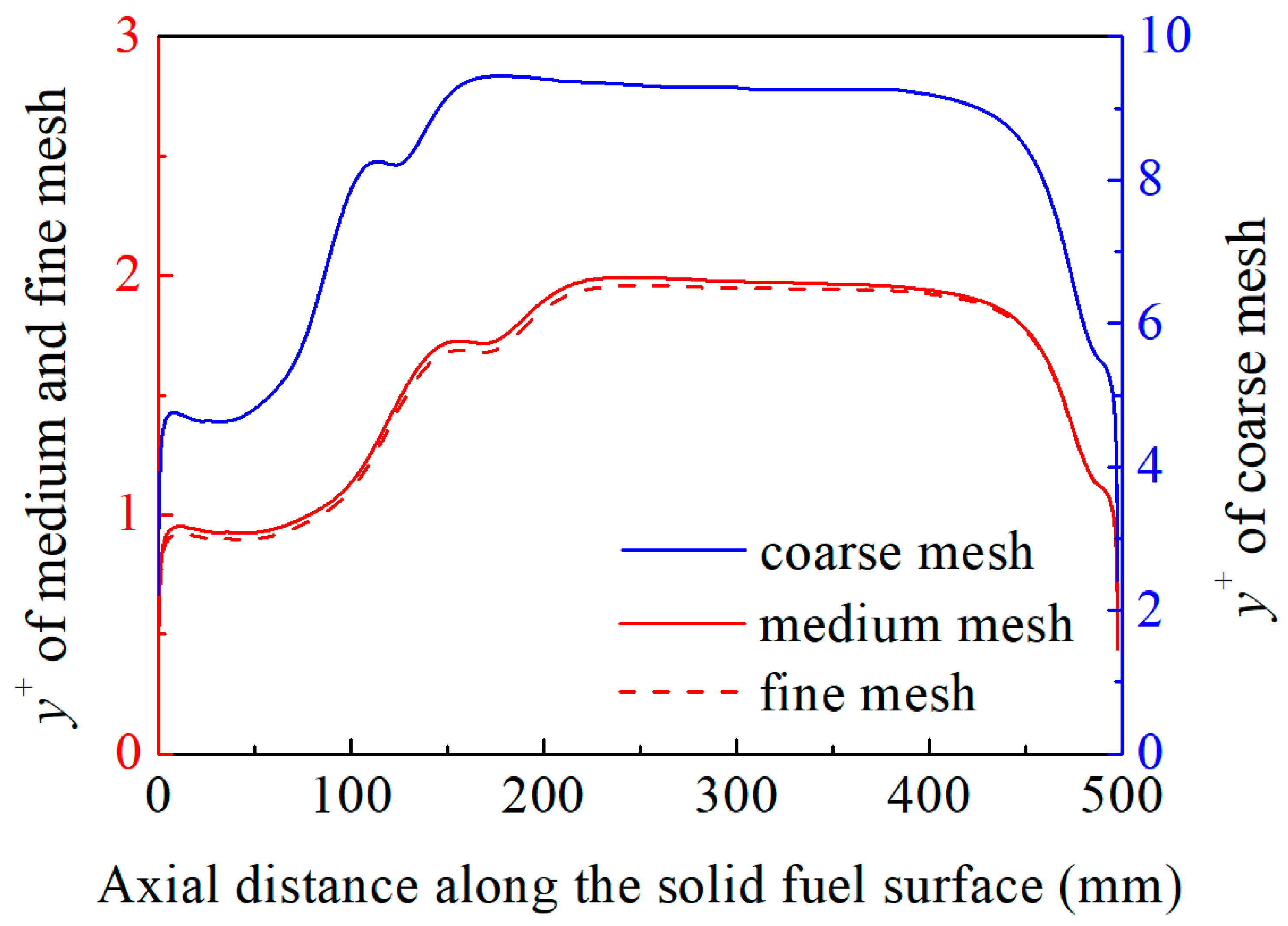
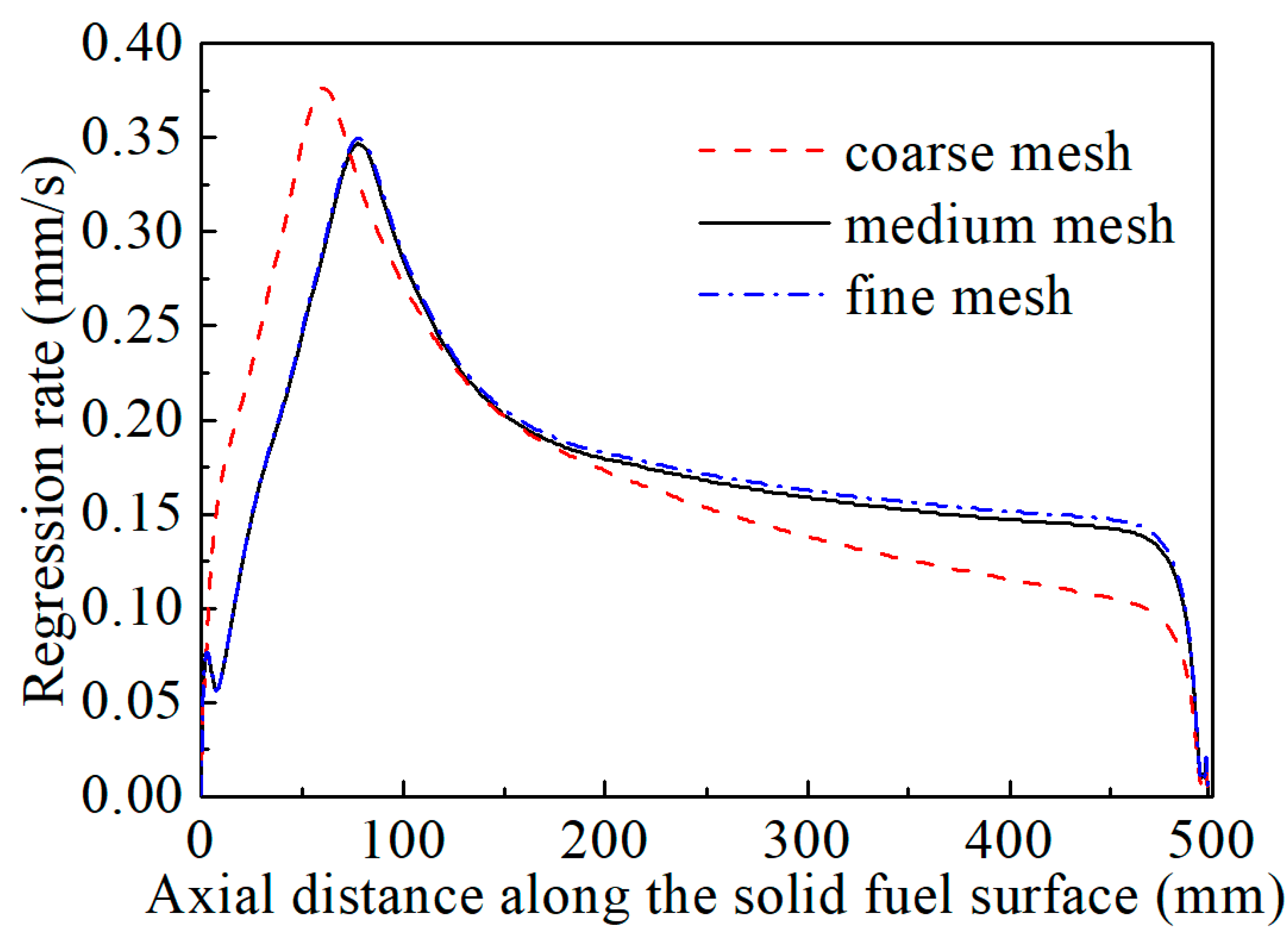




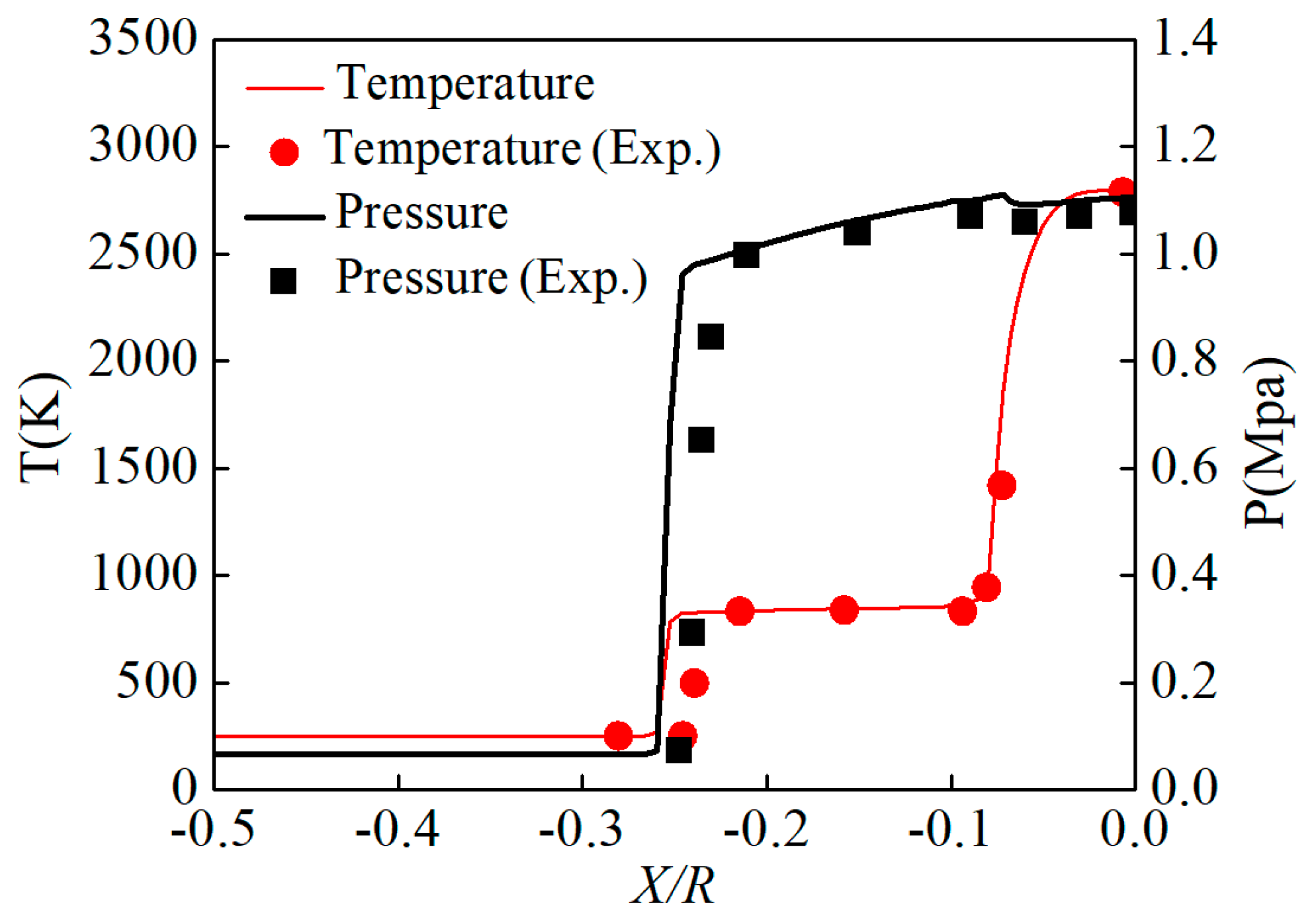





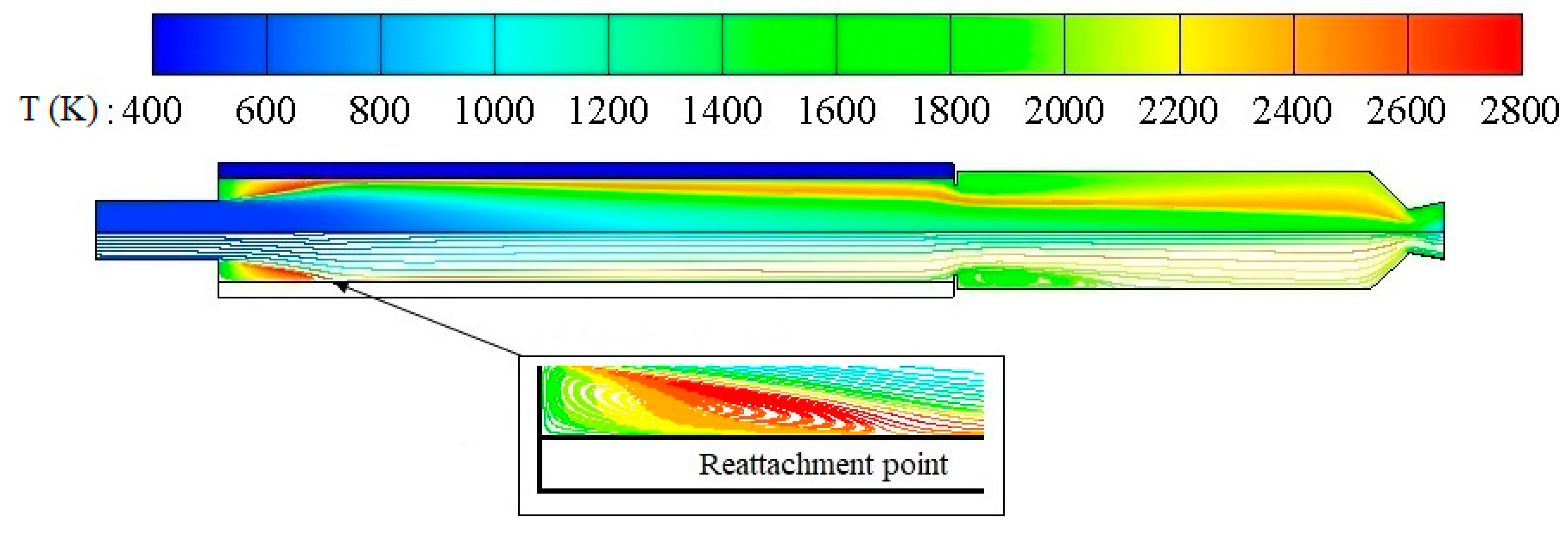
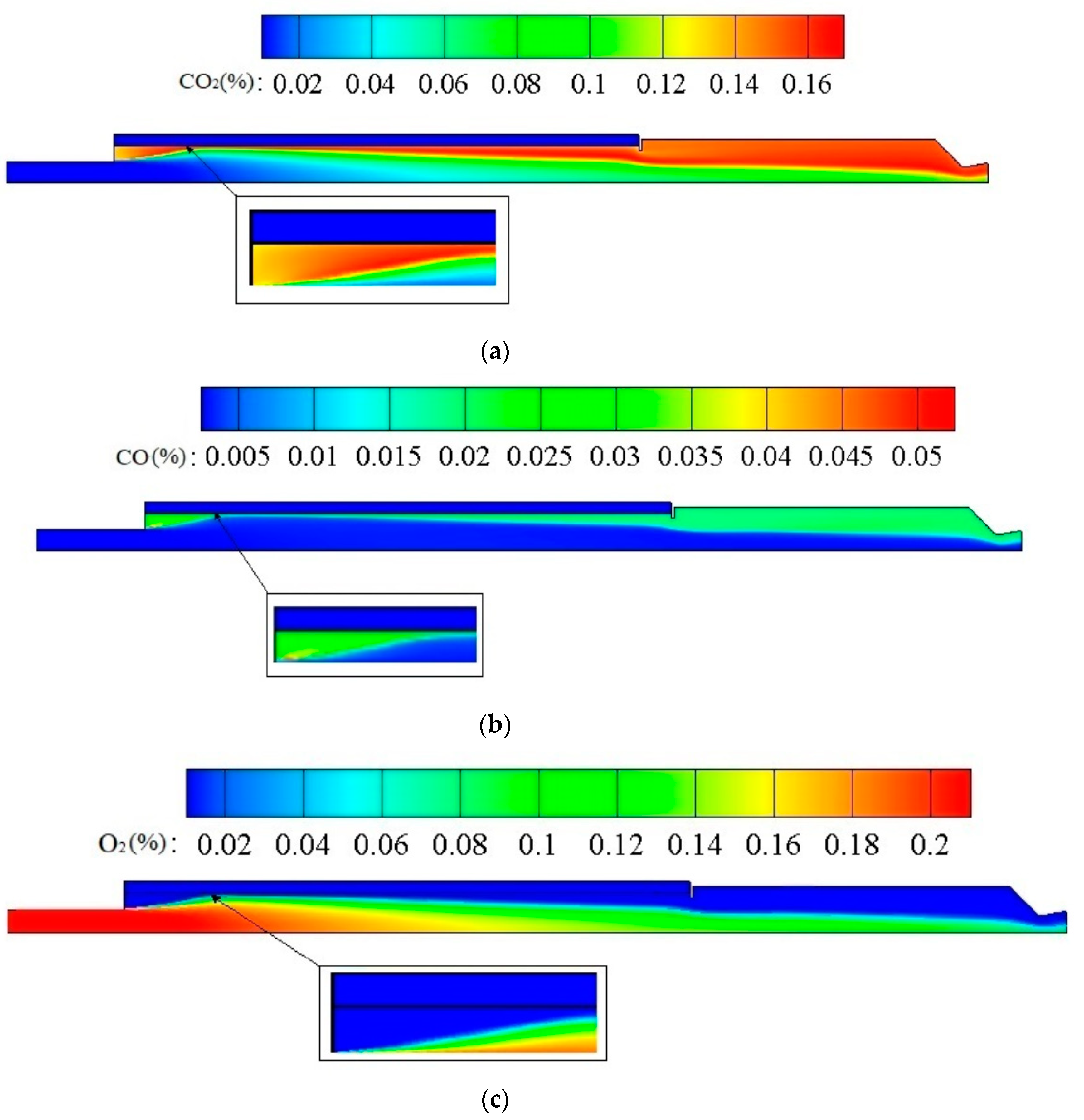
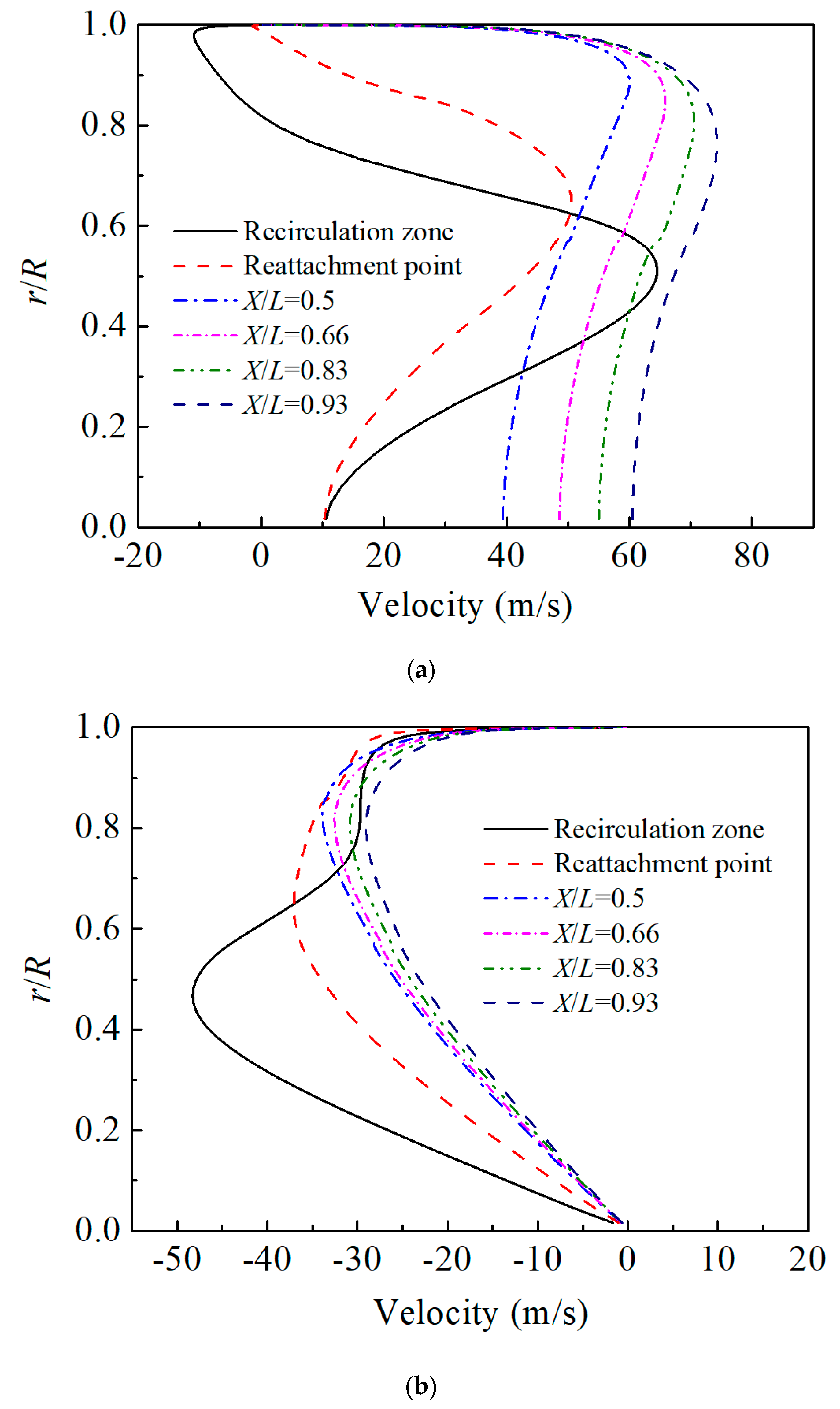


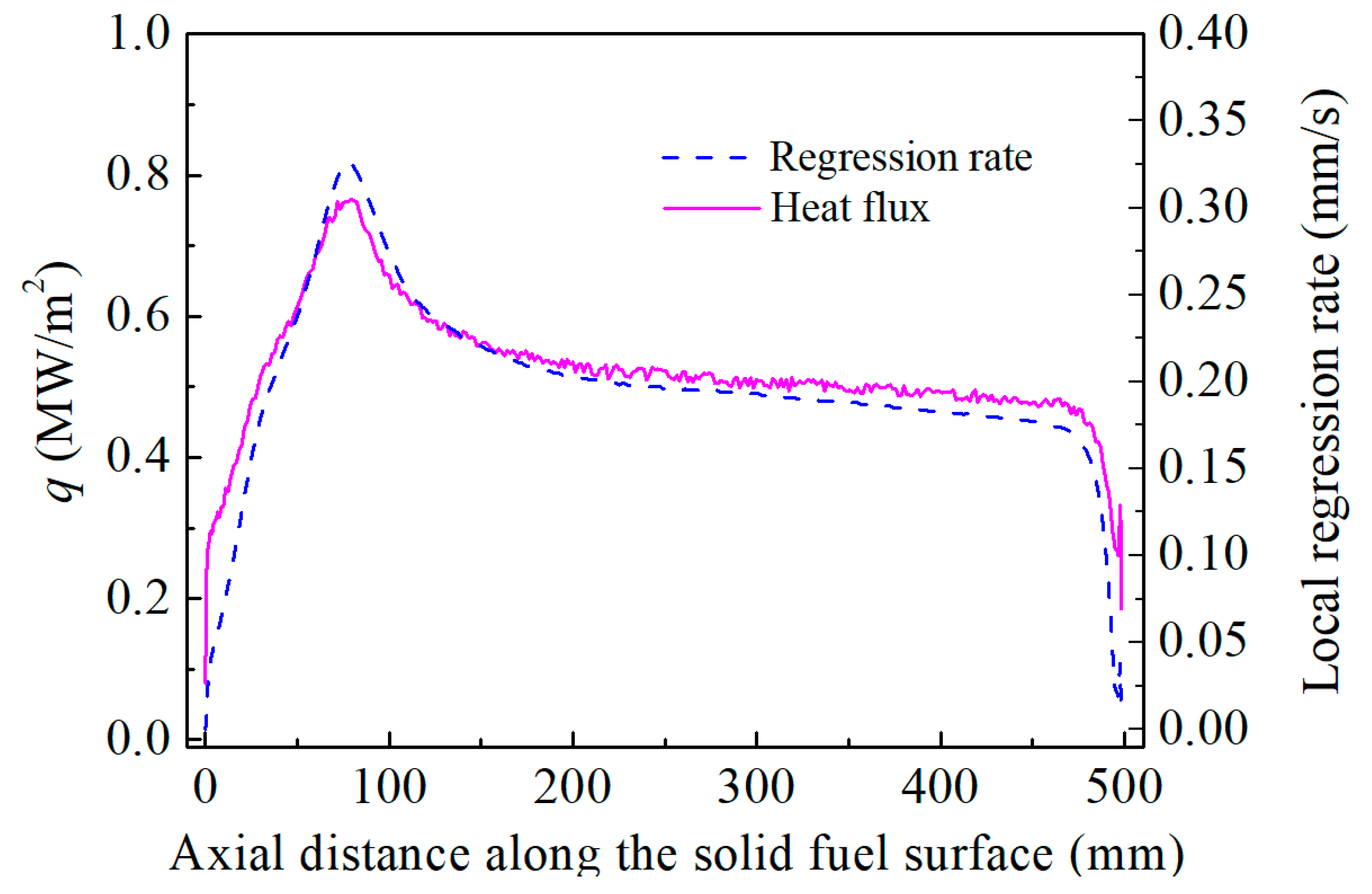

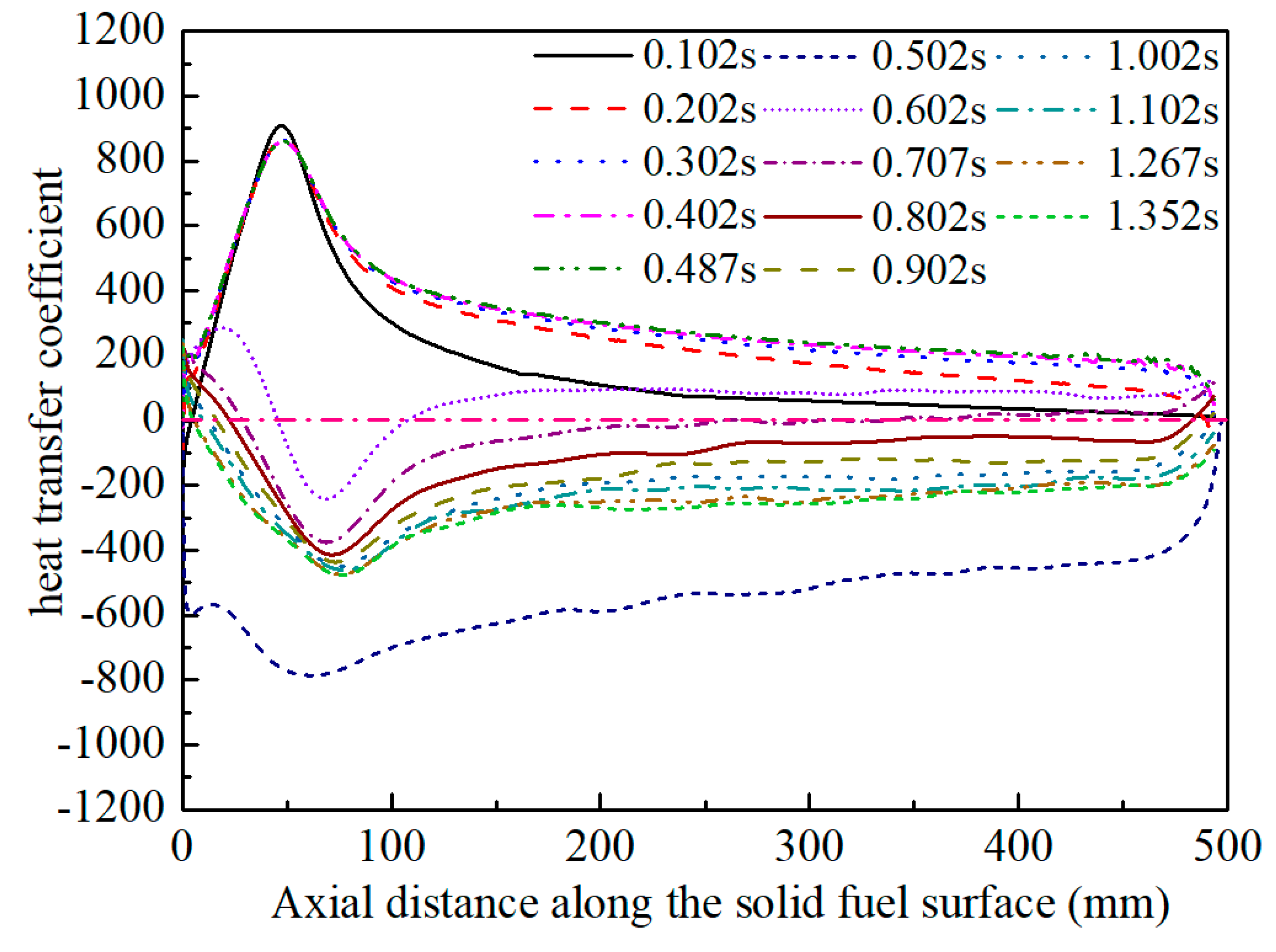
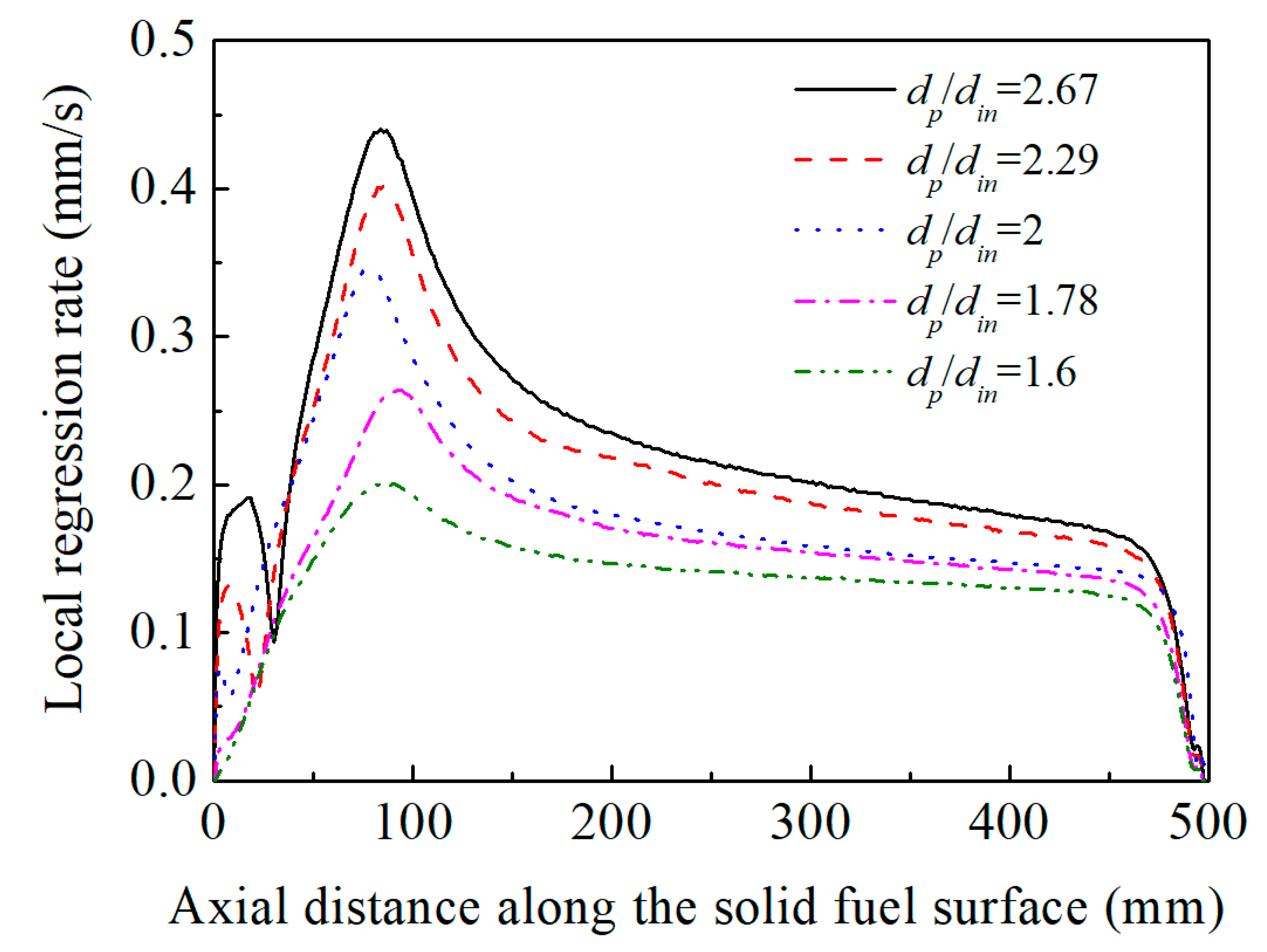
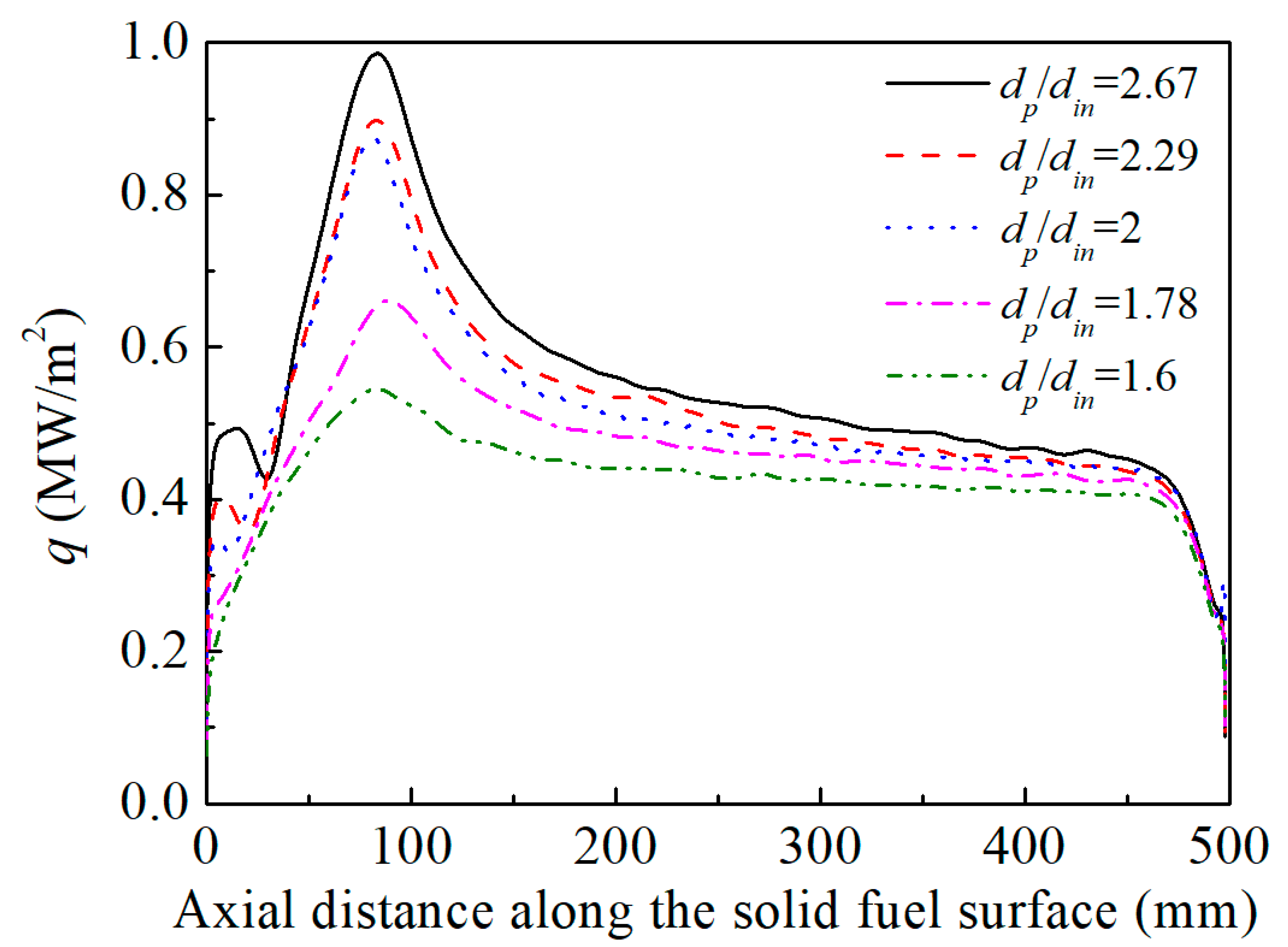

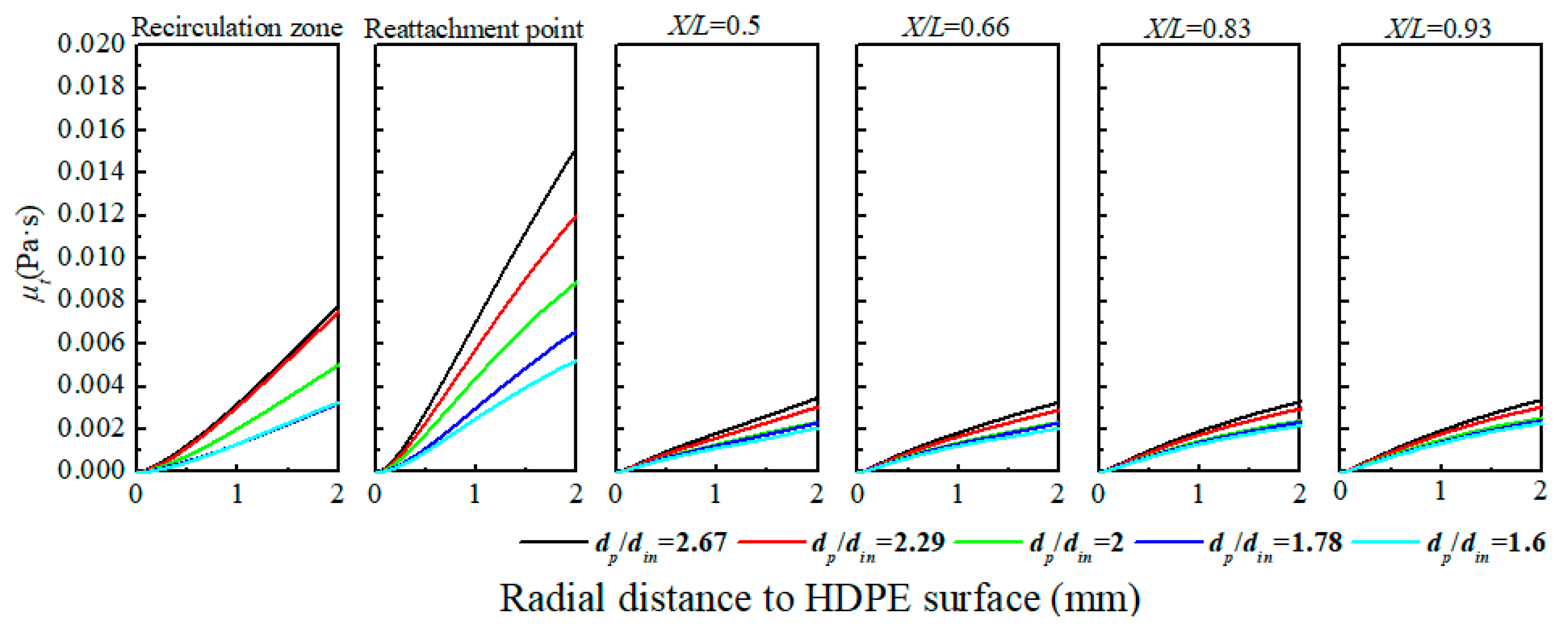

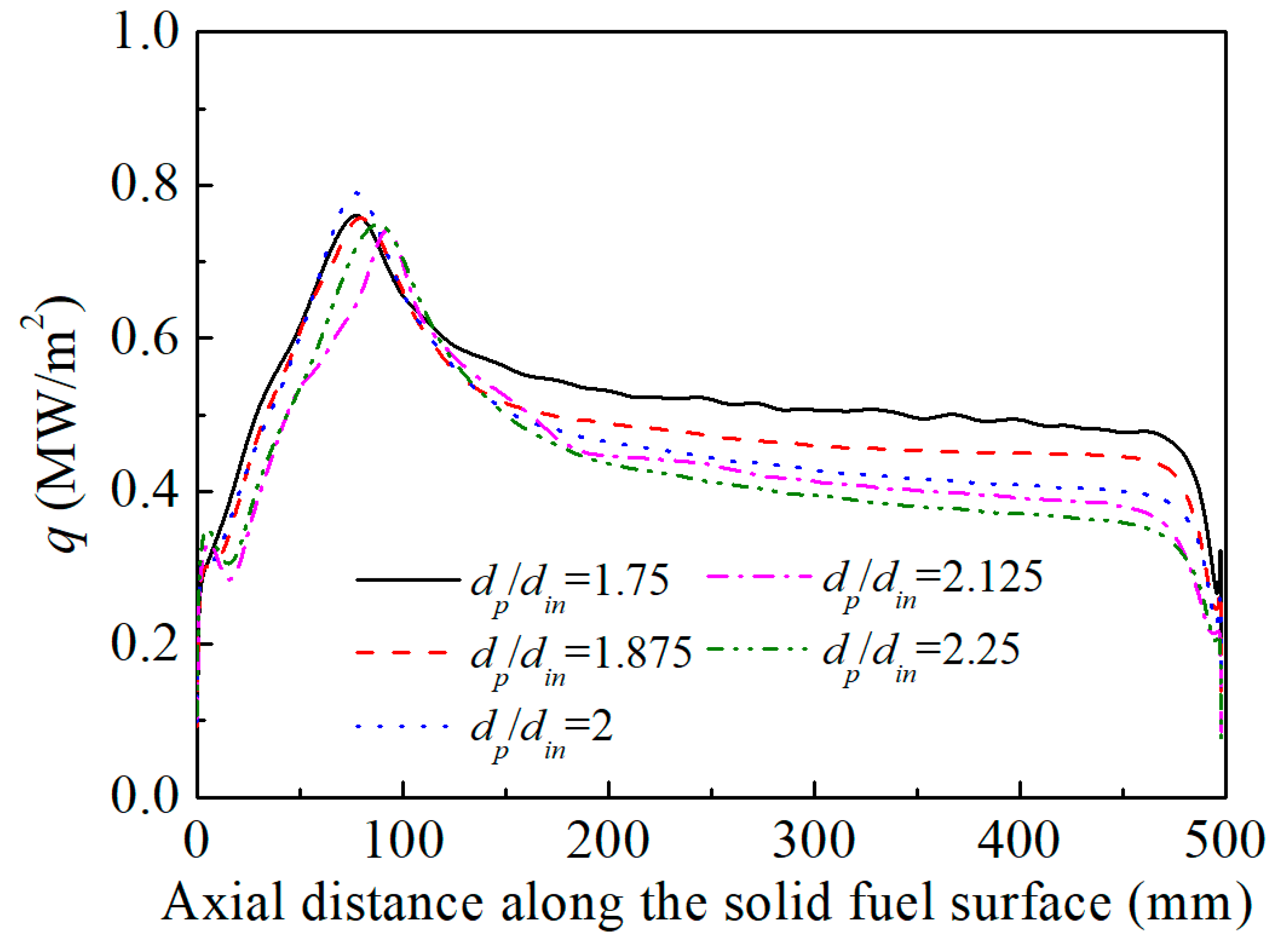
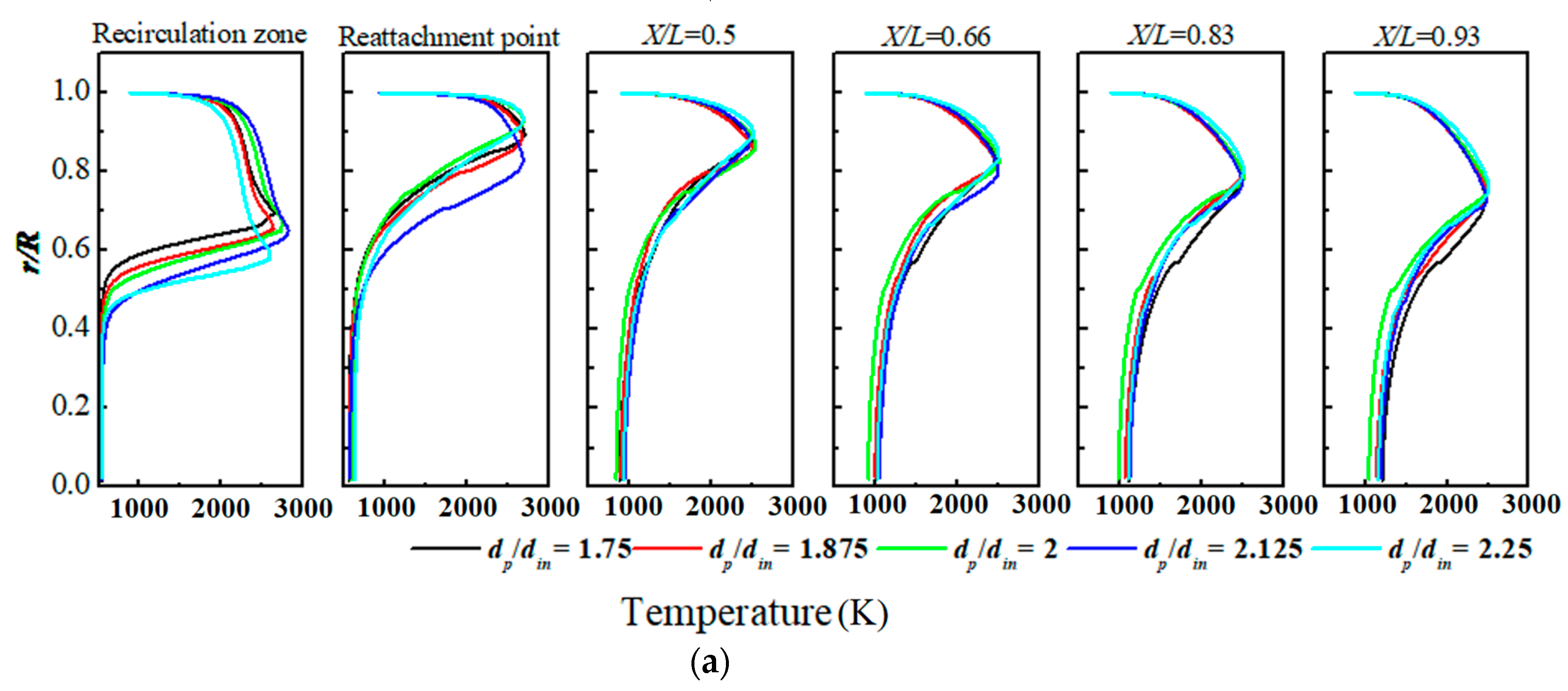
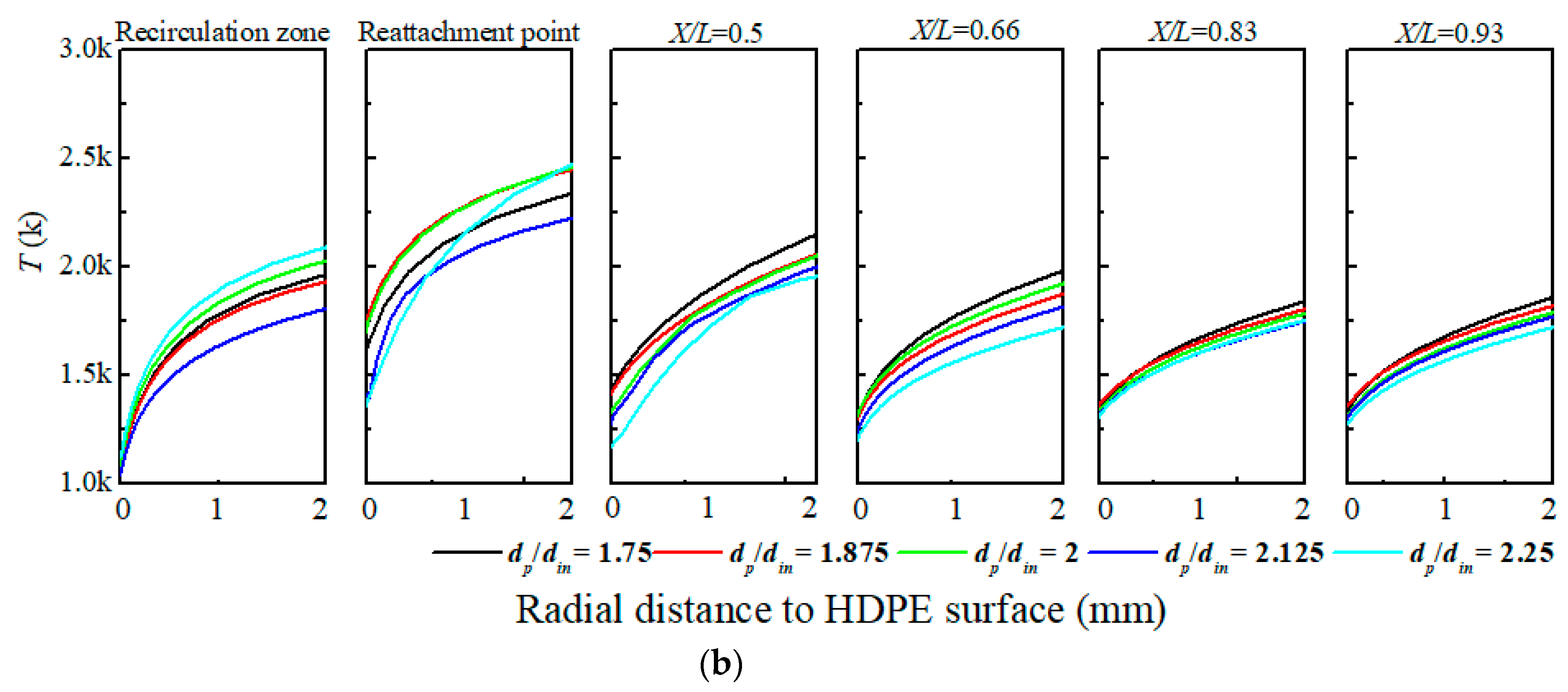


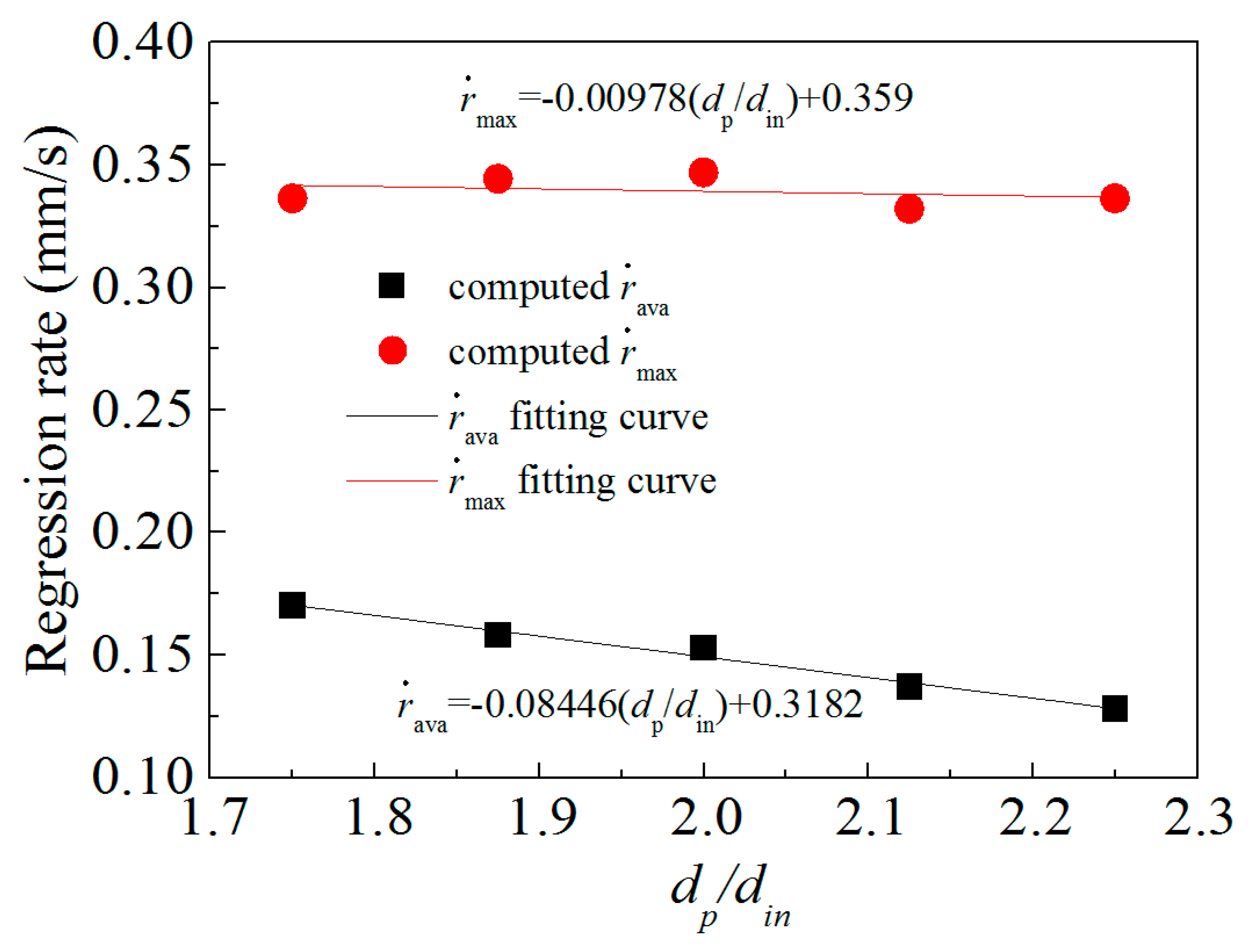
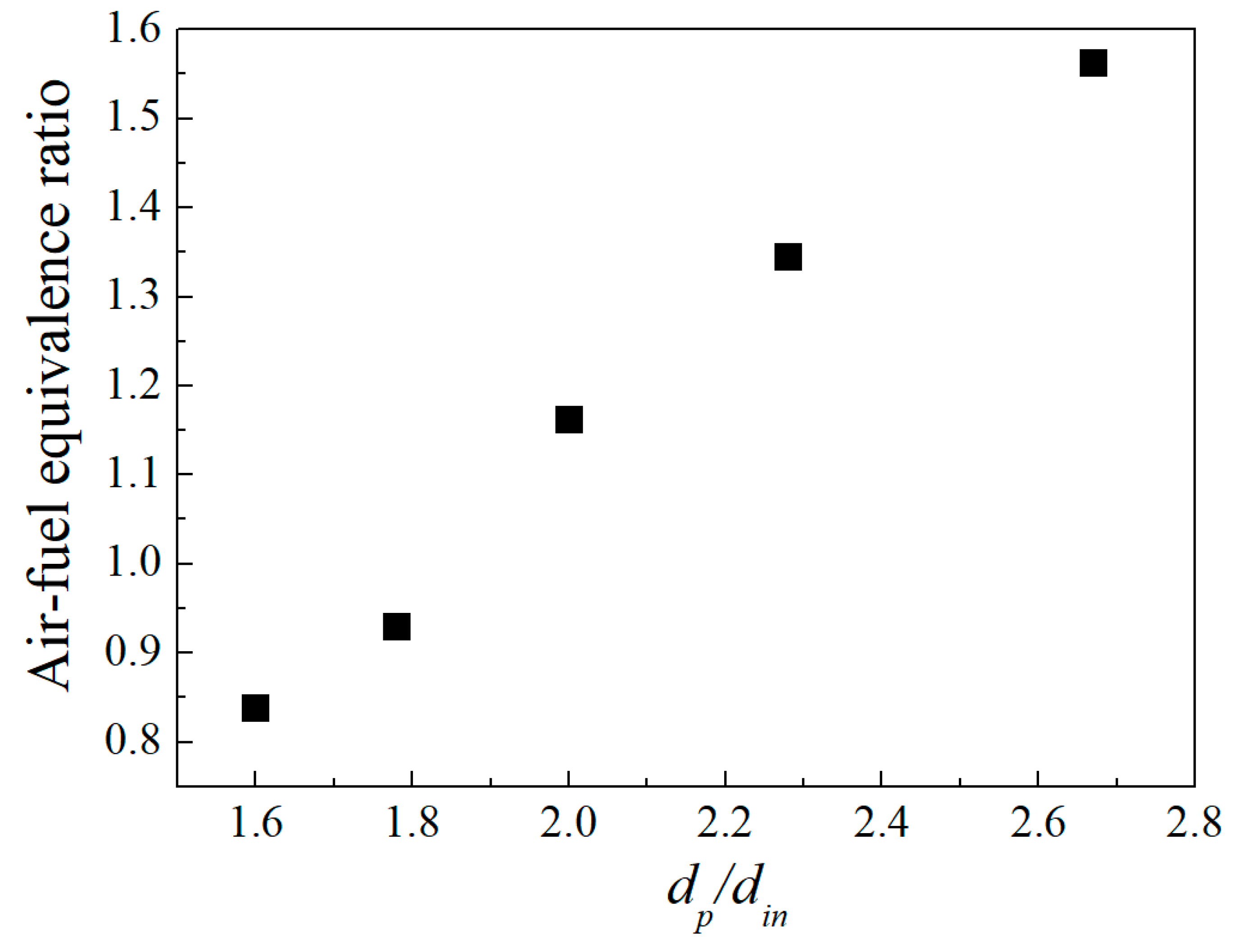

| Reaction | A/(cm3·mol−1s−1) | n | Ea/(j/mol) |
|---|---|---|---|
| 2.10 × 1014 | 0 | 149,779.2 | |
| 3.48 × 1011 | 2 | 84,261.5 | |
| 3.00 × 1020 | −1 | 0.0 |
| Case | s | dp/mm | din/mm | L | dt/mm | /(kg/s) | dp/din |
|---|---|---|---|---|---|---|---|
| 1 | 0.6 | 70 | 40 | 500 | 28.5 | 0.3 | 1.75 |
| 2 | 0.6 | 75 | 40 | 500 | 28.5 | 0.3 | 1.875 |
| 3 | 0.6 | 80 | 40 | 500 | 28.5 | 0.3 | 2 |
| 4 | 0.6 | 85 | 40 | 500 | 28.5 | 0.3 | 2.125 |
| 5 | 0.6 | 90 | 40 | 500 | 28.5 | 0.3 | 2.25 |
| 6 | 0.6 | 80 | 30 | 500 | 28.5 | 0.3 | 2.67 |
| 7 | 0.6 | 80 | 35 | 500 | 28.5 | 0.3 | 2.29 |
| 8 | 0.6 | 80 | 45 | 500 | 28.5 | 0.3 | 1.78 |
| 9 | 0.6 | 80 | 50 | 500 | 28.5 | 0.3 | 1.6 |
| (mm/s) | Simulation | Experiment | Deviation |
|---|---|---|---|
| Mesh Quality | |||
| Coarse | 0.149 | 0.171 | 14.8% |
| Medium | 0.16 | 6.8% | |
| Fine | 0.162 | 5.5% |
| Case | (mm/s) | c* (m/s) | ||||
|---|---|---|---|---|---|---|
| Experiment | Simulation | Deviation | Experiment | Simulation | Deviation | |
| 1 | 0.1936 | 0.1808 | 6.6% | 1176 | 1104 | 6% |
© 2019 by the authors. Licensee MDPI, Basel, Switzerland. This article is an open access article distributed under the terms and conditions of the Creative Commons Attribution (CC BY) license (http://creativecommons.org/licenses/by/4.0/).
Share and Cite
Li, W.; Chen, X.; Cai, W.; Musa, O. Numerical Investigation of the Effect of Sudden Expansion Ratio of Solid Fuel Ramjet Combustor with Swirling Turbulent Reacting Flow. Energies 2019, 12, 1784. https://doi.org/10.3390/en12091784
Li W, Chen X, Cai W, Musa O. Numerical Investigation of the Effect of Sudden Expansion Ratio of Solid Fuel Ramjet Combustor with Swirling Turbulent Reacting Flow. Energies. 2019; 12(9):1784. https://doi.org/10.3390/en12091784
Chicago/Turabian StyleLi, Weixuan, Xiong Chen, Wenxiang Cai, and Omer Musa. 2019. "Numerical Investigation of the Effect of Sudden Expansion Ratio of Solid Fuel Ramjet Combustor with Swirling Turbulent Reacting Flow" Energies 12, no. 9: 1784. https://doi.org/10.3390/en12091784
APA StyleLi, W., Chen, X., Cai, W., & Musa, O. (2019). Numerical Investigation of the Effect of Sudden Expansion Ratio of Solid Fuel Ramjet Combustor with Swirling Turbulent Reacting Flow. Energies, 12(9), 1784. https://doi.org/10.3390/en12091784





